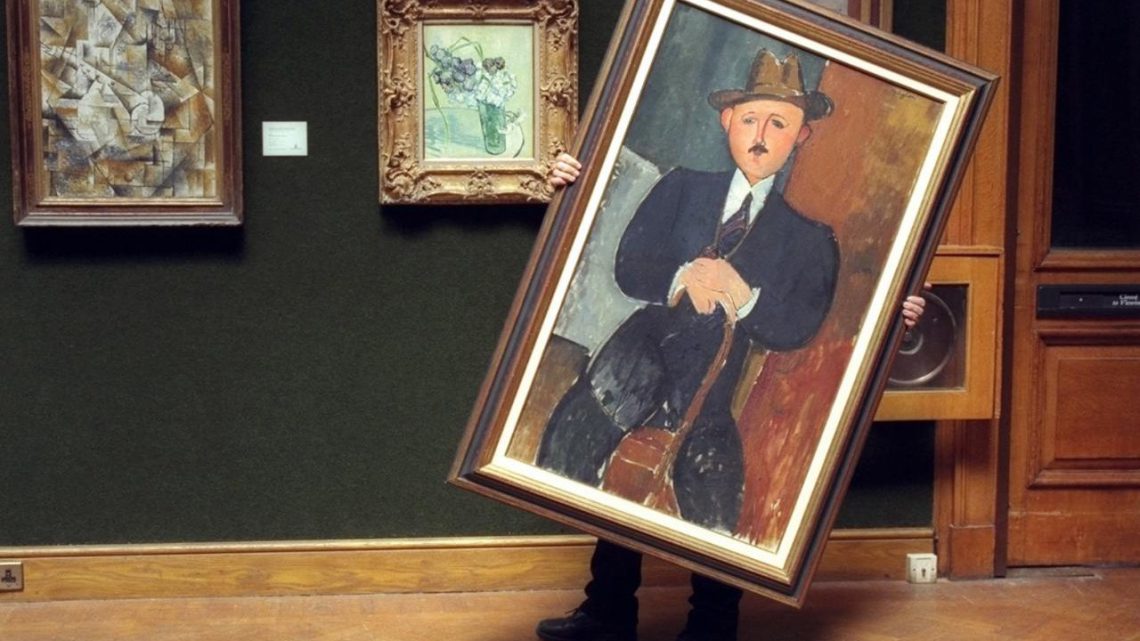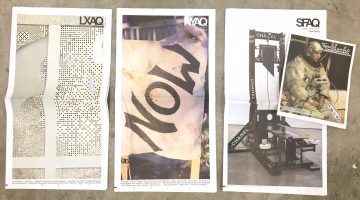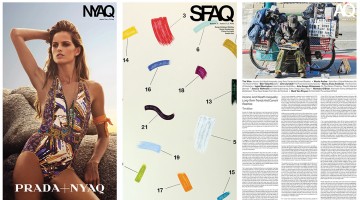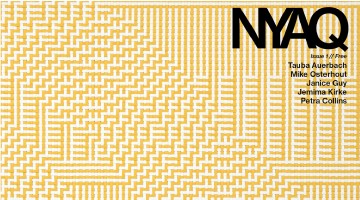When the Panama Papers story broke in April of this year, the promise of pulling back the screen on an entire secret domain of monetary transactions was palpable. Finally, it would be possible to understand more fully how the offshore financial domain operates and who is hiding their money in “secrecy jurisdictions.” While a share of information has been forthcoming from the International Consortium of Investigative Journalists (the ICIJ) and a handful of world leaders have been nailed as they or their associates have been called out in the press or profiled on the ICIJ website, only a slim fragment of the 2.6 terabytes of information have emerged. In May, a searchable database was launched that allowed users to look up names and organizations and find the web of networks exposed by the Papers. However, this is a far cry from actually knowing what information the leaked documents contain.
Articles, published in news outlets from the Modesto Bee to the Guardian (UK) to Hyperallergic, have focused on unseemly dimensions of the art market that are exposed by the Papers. The most comprehensive of these, by the investigative journalist Jake Bernstein working with the ICIJ out of New York, was printed in the Modesto Bee, in Modesto California, a news source that has a daily readership of 216,000.1 Is it wrong to think that no more prominent paper would dare to publish it? To be fair, an article on the art world and the Panama Papers appeared in the Guardian the same day, though it was far shorter.2 Another piece on freeports—unregulated storage sites for art between national jurisdictions—made it to the front page of the Sunday New York Times on May 29th but it did not draw on evidence from the Panama Papers.3 Whether the information in the Panama Papers relating to the art world is being buried or passed over, it has done little to illuminate how offshore financial mechanisms have abetted the development of a lightly-regulated, international art market.
What has been exposed? Both the Bee and the Guardian featured that the sale of the Ganz collection of important modern paintings and sculpture held at Christie’s in London in 1997 had a third-party guarantee provided by the British businessman Joe Lewis, Christie’s largest shareholder at the time. A third-party guarantee is a way for auction houses to guarantee a minimum value to the seller by finding a third party to guarantee an undisclosed minimum price for an artwork offered at public sale. This guarantee took a very particular form: an auction house that Christie’s had recently acquired, Spink & Son, sold the paintings to an offshore company, Simsbury International, for $168 million a month before the sale. Simsbury International was only founded a month earlier, ostensibly for the purpose of this transaction. When the sale of the Ganz collection brought in a record-setting $206.5 million, the difference was split between Spink & Son and Simsbury . . . between Christie’s and Christie’s largest shareholder. So that’s how third-party guarantees work? Not necessarily—but both Bernstein and the Guardian point out that this was the beginning of the third-party guarantee device that has done so much to increase prices in the art auction market. Christie’s catalog for the auction clearly stated that Christie’s had a financial stake in the objects for sale (when is this not the case?), but there is no reason that such elaborate forms of subterfuge would be necessary if the guarantor wasn’t a shareholder in the company.
According to Bernstein, “The documents reveal sellers and buyers of art using the same dark corners of the global financial system as dictators, politicians, fraudsters, and others who benefit from the anonymity these secrecy zones offer.”4 Indeed, this assertion, similar to one I made in the pages of AQ last year, is sustained by the Panama Papers. The information at Bernstein’s fingertips demonstrates not only that it happens but also how it works. To wit: the Nahmad family, a wealthy pair of Lebanese brothers and their sons who run modern art galleries in London and New York, is reported to have thousands of works of art stored in freeports, but when Philippe Maestracci, the grandson of a Jewish art dealer, lodged a restitution claim for a Modigliani painting traced to their collection, the Nahmads asserted that they did not own it in federal and state court, as Berstein reports. The Nahmad family has also asserted that Maestracci’s grandfather never owned the painting. The Panama Papers demonstrate that, in fact, they do as sole shareholders of Art Center International, an offshore corporation registered in Panama. The directors of the corporation are not shareholders and are called “nominees” because they run the company only on paper and neither own nor control the company’s assets. So when Maestracci filed suit he was unable to connect the Modigliani to the Nahmads. Thus, this offshore company is nothing more than a way to hide assets where they can be held indefinitely without regulatory oversight.
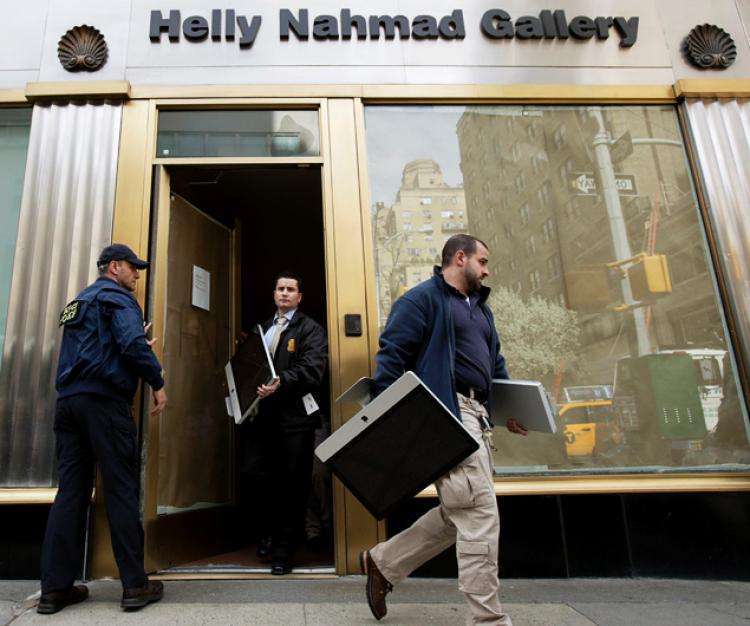
Federal agents remove computers from New York’s Helly Nahmad Gallery located inside the Carlyle Hotel on April 30th, 2014. Courtesy of the Internet.
This might be called a triple-screen. First, these works of art are owned by a private family, so the public does not have a way of finding out who the owners of an artwork might be unless the painting passes into the public realm through an auction or exhibition. Since privacy is something that democratic governments have a strong interest in protecting, keeping art in private hands and out of public view cannot really be thought of as scandalous. However, in the Maestracci case, the Modigliani was auctioned in 1996 at Christie’s in London and was later shown in one of the Nahmads’ galleries, so the painting entered the public record. The second screen is the offshore company that “holds” the works of art. Due to the nature of the company, incorporated in a secrecy jurisdiction, the real owners of the company’s assets are protected and it is impossible to trace the works of art to any individual. Finally, the works themselves are held in a freeport, a tax-free zone established for the sole purpose of protecting objects in a discrete legal domain until they are transferred to another location. In December of 2015, the Swiss passed laws to increase regulation slightly at the Geneva Freeport, but new ones have been popping up in tax havens around the world, from Luxembourg to Singapore, to Delaware.
This triple-screen is part of developing business models in an era of globalization, when having foreign subsidiaries is a common way that companies avoid their tax burdens, it shouldn’t come as a surprise that an international art dealing firm run by the Nahmad family should use these practices as well. But Bernstein notes:
The Nahmads’ business, which stretches across jurisdictions and blood ties, is tailor-made for offshoring. With the Nahmad principals based in three countries, galleries on opposite sides of the Atlantic Ocean and most of the paintings stashed in Switzerland, the family requires the kind of legal siloing made possible by offshore companies.5
Fair enough—the Nahmad example fits the model of secretive market processes. This brings up two big questions. First, are these practices the norm? Is it possible that many dealers use offshore companies and freeports to hide the ownership of works of art? The second question is more specific to the Nahmad family: Why have none of these writers put two and two together and introduced the issue of the Nahmad family’s third-party guarantees, which they are reported to provide regularly to Christie’s and Sotheby’s? Further, what has happened to all of the works of art that they have acquired through these sales? Are these the works that are now in freeports?
The problem with the release of information from the Panama Papers is that it is impossible to answer these questions with information from these leaks, no matter how large they are. Searching through the database with the names of other dealers whether of Old Master and modern art (William Acquavella, Richard Feigen) or contemporary art (Larry Gagosian, David Zwirner) reveals no hits. In other words, it would seem that the Nahmads are bad apples, so to speak, when it comes to using secrecy jurisdictions to shore up art market advantage. However, the name Wildenstein also did not yield any results, and, thanks to a trial held this year in France, it’s well known that Guy Wildenstein was hiding art and money through tax-avoidance schemes. So it is fair to say that the database is far from complete, and thus the Panama Papers, as currently configured, cannot tell us whether there is widespread use of offshore mechanisms among the central figures in the art market. There is a lot of data there, but it is not all useful.
Looking more specifically at the Nahmad family, here again one confronts the limits of journalism and of leaks that seek to let the public know about events that shape the world behind the scenes. In court, the Nahmads denied owning a work of art that was owned by a corporation of which they were secretly the shareholders. This is a newsworthy story for the art press. However, the New York Times reported in an article in 2013 that the Nahmads have more than 3000 works of art stockpiled in a duty-free warehouse near Geneva, and it has also been widely reported that the same family regularly provides third-party guarantees at auctions. So, can’t the Panama Papers explain how their business model operates? If they are manipulating the art auction market through third-party guarantees and purchases that they are storing away in a freeport, the Panama Papers have not so far exposed it.
Investigative journalism is a noble profession in decline in our neoliberal era, and the ICIJ is providing a highly visible platform for its continuation, but it does not, and cannot, answer all relevant questions. By pursuing stories and working with specific sources, journalists are limited to reporting what those sources reveal, and it is quite likely that the Panama Papers do not provide enough information to put all of these pieces together. The searchable database certainly does not provide the answers. While the public is wowed by salacious discoveries of the misdeeds among a handful of actors, the fundamental operations of the art market remain obscured.
This partial disclosure is the problem with the Panama Papers, and other similar leaks. Once the public discovers the actions behind the scenes, whether it be in the realm of finance, diplomacy, or even on the part of government agencies (like the NSA), there is an initial shock and a sense that all of these newly exposed deceptive tactics should be somehow curtailed. While some changes have resulted from WikiLeaks, the Snowden revelations, and the Panama Papers, the common element here is that they cause a big dust-up and then disappear with the news cycle. Individuals, even some within the government, call for change and institutions do not respond. While the Panama Papers will definitely be bad for Mossack Fonseca, and for a handful of politicians and dealers whose investments were exposed, they will not tell us what goes on behind closed doors and they will not explain how those who have the greatest share of wealth manage to protect it from tax authorities, employing art as a tangible and unregulated asset.
When forms of abuse are exposed, there is a desire to generalize and to imagine that these practices are something like the norm. In the case of the Panama Papers, evidence suggests that these cases are exceptional, but the demand for new freeports is apparently increasing so something is going on behind closed doors. When money and art move offshore, finance and the art market are impacted, but the nature of these transactions hides new economic processes behind a triple screen.
1) Bernstein, J. (2016). Hiding Money: The Art of Secrecy. Modesto Bee (April 7, 2016). Accessed at http://www.modbee.com/news/nation-world/world/article70505092.html#storylink=cpy.
2) Garside, J., Bernstein, J., & Watt, H. (2016). How offshore firm helped billionaire change the art world forever. The Guardian (April 7, 2016). Accessed at: https://www.theguardian.com/news/2016/apr/07/panama-papers-joe-lewis-offshore-art-world-picasso-christies.
3) Bowley, G. and Carjaval, D. (2016). One of the World’s Greatest Art Collections Hides Behind This Fence. New York Times (April 28, 2016). Accessed at: http://www.nytimes.com/2016/05/29/arts/design/one-of-the-worlds-greatest-art-collections-hides-behind-this-fence.html?smid=nytcore-ipad-share&smprod=nytcore-ipad.
4) Bernstein, op.cit. n.p.
